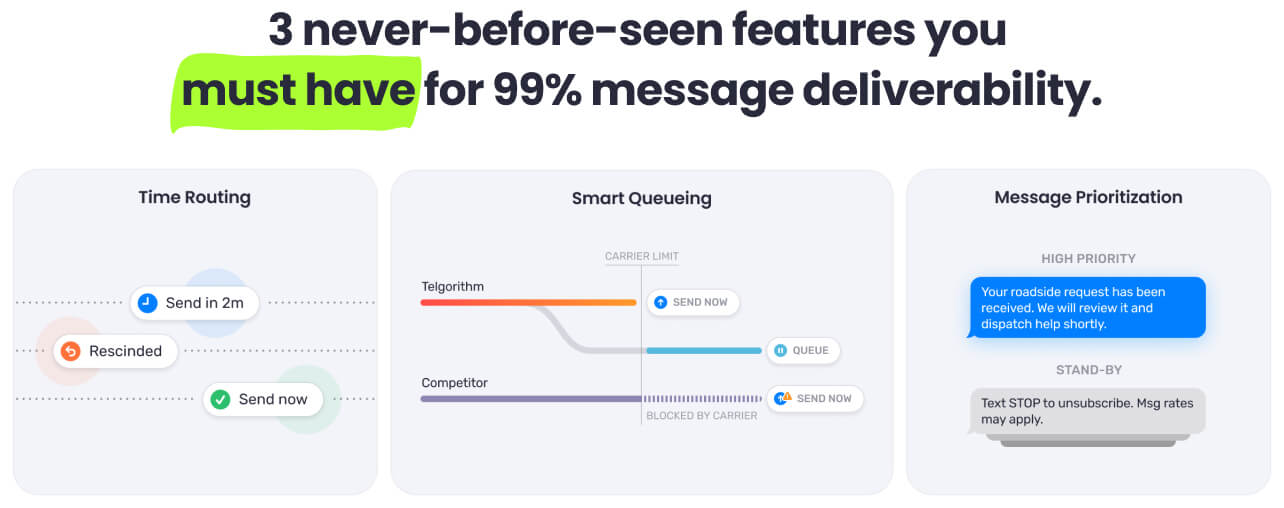New Text Messaging Regulations Impacting SaaS: From compliance to deliverability
If you’re running SMS & MMS text messaging for your customers, there are new mandatory business text message requirements to be aware of that will affect your text messaging deliverability, revenue and customer retention if not addressed.
As of this year, in an effort to stop spam messaging, all major messaging API providers of business text messaging, (application-to-person (A2P) messaging), now require their customers to register their local numbers or 10-digit long code (10DLC) with The Campaign Registry (TCR).
TCR was created to validate businesses and their messaging campaigns to protect mobile users from scammers and reduce the risk of spam. In late 2020, it was launched in conjunction with the Carrier’s A2P 10DLC rollout to oversee the registration of 10DLC numbers and associate them with specific campaigns.
Registration involves businesses being vetted, agreeing to compliance requirements, and enabling message filtering mechanisms to identify and block spam. Certain carriers, like T-Mobile, AT&T, and Verizon, already implement even higher pass-through fees – up to $0.01 for SMS – on unregistered messages sent to encourage businesses to comply.
The challenge with new registration deadlines
TCR registration is now mandatory industry-wide. However, each provider has set its own deadline, and any unregistered SMS and MMS messages sent after those have passed will be completely blocked. Twilio – one of the largest messaging API companies – has announced a complete cutoff of unregistered 10DLC messages by August 31 this year.
The deadlines have led to businesses rushing to register their 10DLC numbers at once. This has created bottlenecks and huge wait times of eight weeks or more.
Why does this pose such a challenge? Because eight-week delays would put businesses past the deadline, causing their messages to be blocked, leading to massive loss of revenue and customer churn if they are unable to send messages even for a day.
How to avoid registration delays
Telgorithm, Inc stands out as a provider which foresaw the challenges in the business text messaging industry and addressed them proactively.
The company adopted 10DLC messaging early, so it has been working on making the registration process as quick and painless as possible by introducing automated registration. Telgorithm has integrated its APIs with TCR’s, so that when its customers register as Campaign Service Providers (CSPs) with TCR, the information inputted gets sent directly to Telgorithm. It is then automatically imported into the customer’s Telgorithm account, so they do not need to fill it in twice. The automation significantly reduces the risk of typos that can lead to Brand and Campaign rejections, and speeds up the registration process to just a matter of days.
Additionally, after you submit for TCR registration and become a CSP, your Campaigns must be vetted by your provider’s Direct Connect Aggregator (DCA). This vetting process is manual and currently takes between four to eight weeks to complete, causing messages to remain unregistered until approved. That means higher Carrier pass-through fees and possible disruptions if a Campaign is not vetted and approved by the registration deadline. But, thanks to Telgorithm’s trusted relationships with the DCAs, the current wait time for its customers to get Campaigns fully approved and compliant is five to seven days.
Once you are a CSP with TCR, you can demo Telgorithm’s Campaign vetting approval speed for yourself. This requires zero coding or contract to test.
The faster a company gets registered, the faster it can be confident its messages won’t be blocked. It can also start to take advantage of the benefits that come with registration; lower carrier pass-through fees and less filtering. However, the most significant benefit is higher messaging throughput or rate limits, increasing the number of text messages a Campaign is able to send within a specific time.
Rate limits were established to both prevent the Carriers’ systems from being overwhelmed or bottlenecked, and protect the end user from unsolicited messages and/or spam. It’s important to know that each Carrier monitors rate limits differently. For example, Verizon monitors by messages sent per number per minute, while AT&T monitors by messages sent per Campaign per minute. T-Mobile, on the other hand, has a daily cap, monitoring messages sent per day, inclusive of all Campaigns that sit under the given Brand.
The biggest takeaway is that if your Campaign sends more messages than allotted by each Carrier – the message will be blocked and therefore not received by the end user.
The mission-critical importance of keeping track of your rate limits
New requirements mean we need to be thinking about managing messaging differently. Although the increased rate limit may appear to be a sure victory, being able to leverage it after registration is not guaranteed. A provider must have new, dedicated technology in place to properly manage customer campaigns and keep track of their individual rate limits, as well as the number of messages going to each Carrier.
Not being aware of these for each of your customers’ Brands and Campaigns leads to either unnecessary message capping, or exceeding rate limits, meaning those texts will be dropped or blocked. This contributes to a negative customer experience due to poor deliverability and, ultimately, stumps business profitability.
How to take control of rate limits
Telgorithm, founded by telecom industry experts who have been the customers of API providers in the past, is equipped with essential tech to ensure deliverability.

Source: Telgorithm
Along with an overall ease of use due to automation, Telgorithm has built a suite of tools that achieves an average of 98.7% text message deliverability for its customers. One of these is Smart Queueing which automatically tracks and manages your approved TCR and Carrier rate limits so you can send at the fastest speeds without ever exceeding your limits; any additional messages are queued up to send at the next available opportunity.
Working in tandem with Smart Queueing, Message Prioritization enables you to proactively program your most urgent messages to be delivered first so that they’re not sitting in the queue.
Next, Time Routing allows you to strategically determine what happens with the messages that are queued. You can rescind the messages from the queue that no longer need to be sent, or schedule them to be sent during a specific time period to give the end user the best possible experience.
Telgorithm customers can therefore optimize their rate limits, reduce expenses, and enhance the overall customer experience. Other features include Number Verification, which checks that numbers are real and in service before a message is sent, saving on costs and also helps guarantee deliverability.
Why Telgorithm?
Telgorithm is a next-gen A2P text messaging API provider and the only one to automate the entire SMS & MMS journey from compliance to deliverability, enabling SaaS businesses to grow revenue and improve customer experience. Founded by a team of telecom experts that anticipated the new era of business text messaging, it built tech to support businesses through the industry-required changes and continues to enable their success on the pathway after registration.
With the upcoming deadlines marking a new era for A2P messaging, Telgorithm wants to help your business adapt. It can guide you through 10DLC registration and ensure it goes as quickly and smoothly as possible with automated processes. After that, it will take control of your customers’ rate limits for you, ensuring they are never capped or exceeded. Overall, its suite of dedicated API tools achieves 99% message deliverability for your customers.
Telgorithm’s mission is to offer a more reliable and transparent business text messaging service that prioritizes helping its customers understand the latest industry changes which impact them. At the same time, it doesn’t expect anyone else to be experts, so it offers direct lines of communication to support teams and engineers, allowing customers to focus on what’s important to their business. Telgorithm is the future of A2P text messaging for any SaaS business offering SMS & MMS messaging to their customers today.
To learn more about how Telgorithm can help you improve your message deliverability and overall experience for your customers to grow revenue, visit its website.









